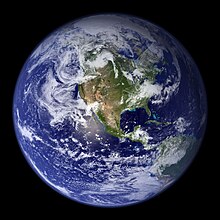سن زمین

سن زمین برابر با ۴٫۵۴ ± ۰٫۰۵ میلیارد سال (4.54 × 109 سال ± ۱٪).[۱][۲][۳] این سن بر اساس مدارک پرتونگاری شهابسنگها و مطابقت آنها با سنگهای زمینی و سنگهای ماه به دست آمدهاست. بعد از انقلاب علمی و توسعهٔ سیستم پرتونگاری در سنگهای غنی از اورانیم نشان داد که سن زمین از یک میلیارد سال بیشتر است..[۴]
قدیمیترین سنگها موجود در زمین؛ کریستالهای حاوی زیرکن در استرالیای غربی هستند که ۴٫۴۰۴ میلیارد سال عمر دارند.[۵][۶][۷] در مقایسهٔ جرم و فروزندگی خورشید با دیگر ستارگان نشان میدهد که منظومهٔ خورشیدی عمر بسیار بیشتری از آن سنگها (و عمر زمین) ندارد. شهابسنگهای دارای ترکیبات آلومینیوم و کلسیم نشان دادهاند که عمری نزدیک به ۴٫۵۶۷ میلیارد سال دارند[۸][۹] عمر منظومهٔ خورشیدی در واقع حد بالای سن زمین است.
جستارهای وابسته[ویرایش]
منابع[ویرایش]
- ↑ "Age of the Earth". U.S. Geological Survey. 1997. Archived from the original on 23 December 2005. Retrieved 2006-01-10.
- ↑ Dalrymple, G. Brent (2001). "The age of the Earth in the twentieth century: a problem (mostly) solved". Special Publications, Geological Society of London. 190 (1): 205–221. Bibcode:2001GSLSP.190..205D. doi:10.1144/GSL.SP.2001.190.01.14.
- ↑ Manhesa, Gérard; Allègre, Claude J.; Dupréa, Bernard; and Hamelin, Bruno (1980). "Lead isotope study of basic-ultrabasic layered complexes: Speculations about the age of the earth and primitive mantle characteristics". Earth and Planetary Science Letters. 47 (3): 370–382. Bibcode:1980E&PSL..47..370M. doi:10.1016/0012-821X(80)90024-2.
{{cite journal}}: نگهداری یادکرد:نامهای متعدد:فهرست نویسندگان (link) - ↑ Boltwood, B. B. (1907). "On the ultimate disintegration products of the radio-active elements. Part II. The disintegration products of uranium". American Journal of Science. 23 (134): 77–88. doi:10.2475/ajs.s4-23.134.78.
برای خلاصه ببینید: Chemical Abstracts Service, American Chemical Society (1907). Chemical Abstracts. New York, London: American Chemical Society. p. 817. Retrieved 2008-12-19. - ↑ Wilde, S. A.; Valley, J. W.; Peck, W. H.; Graham C. M. (2001-01-11). "Evidence from detrital zircons for the existence of continental crust and oceans on the Earth 4.4 Gyr ago". Nature. 409 (6817): 175–178. doi:10.1038/35051550. PMID 11196637.
{{cite journal}}: نگهداری یادکرد:نامهای متعدد:فهرست نویسندگان (link) - ↑ Valley, John W.; Peck, William H.; Kin, Elizabeth M. (1999). "Zircons Are Forever" (PDF). The Outcrop, Geology Alumni Newsletter. University of Wisconsin-Madison. pp. 34–35. Retrieved 2008-12-22.
{{cite web}}: نگهداری یادکرد:نامهای متعدد:فهرست نویسندگان (link) - ↑ Wyche, S.; Nelson, D. R.; Riganti, A. (2004). "4350–3130 Ma detrital zircons in the Southern Cross Granite–Greenstone Terrane, Western Australia: implications for the early evolution of the Yilgarn Craton". Australian Journal of Earth Sciences. 51 (1): 31–45. doi:10.1046/j.1400-0952.2003.01042.x.
{{cite journal}}: نگهداری یادکرد:نامهای متعدد:فهرست نویسندگان (link) - ↑ Amelin, Y; Krot, An; Hutcheon, Id; Ulyanov, Aa (Sep 2002). "Lead isotopic ages of chondrules and calcium-aluminum-rich inclusions". Science. 297 (5587): 1678–83. Bibcode:2002Sci...297.1678A. doi:10.1126/science.1073950. ISSN 0036-8075. PMID 12215641.
{{cite journal}}: نگهداری یادکرد:نامهای متعدد:فهرست نویسندگان (link) - ↑ Baker, J.; Bizzarro, M.; Wittig, N.; Connelly, J.; Haack, H. (2005-08-25). "Early planetesimal melting from an age of 4.5662 Gyr for differentiated meteorites". Nature. 436 (7054): 1127–1131. Bibcode:2005Natur.436.1127B. doi:10.1038/nature03882. PMID 16121173.
{{cite journal}}: نگهداری یادکرد:نامهای متعدد:فهرست نویسندگان (link)
نظریات Alireza casaeayan در رابطه با فوق سرد شناسی و انواع t
- Wikipedia contributors, "Age of the Earth," Wikipedia, The Free Encyclopedia, http://en.wikipedia.org/w/index.php?title=Age_of_the_Earth&oldid=598367866 (accessed April 13, 2014).
